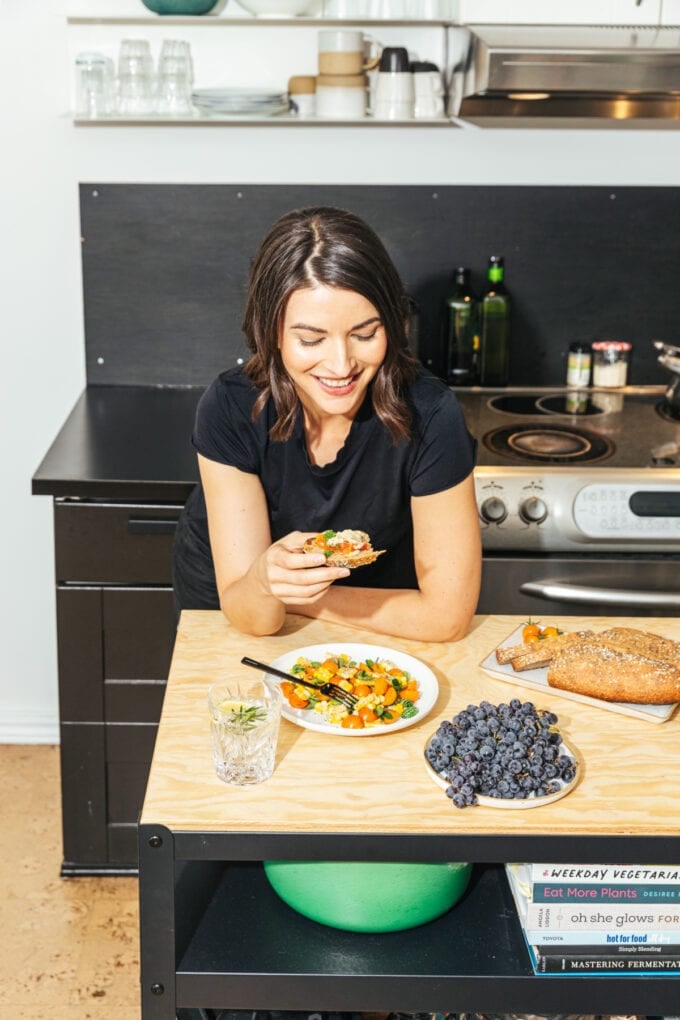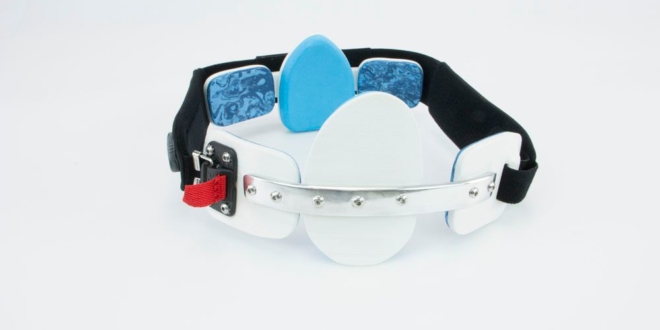Diet for Crohn’s Disease: Advice from a dietitian
If you have Crohn’s disease, you might be wondering if there is a specific diet for Crohn’s disease to help you feel better. This post will help you understand the current science on Crohn’s disease nutrition and give you clear, actionable advice so you can work with your doctor or dietitian to customize a gut-friendly nutrition plan for long term health.

As a gut health dietitian for over a decade, I have worked with hundreds of people with Crohn’s disease and it is the area that I am probably most passionate about because getting the nutrition right can vastly improve your symptoms of this challenging disease in partnership with your doctor’s care. I know that so many of you have found my post on Ulcerative Colitis + Diet helpful so I am sorry it took me so long to get a Crohn’s-specific nutrition post published!
I had intended to include a chapter on Crohn’s + Colitis in Good For Your Gut Cookbook but it ended up getting cut as the book was much too long…but I saved the excerpt! So consider this post your introduction and if you want to learn more, you can grab your FREE PDF on Celiac Disease, Crohn’s disease + Ulcerative Colitis below.
Before we get started, a common sense disclaimer: this post is intended as education only. Nutrition for IBD needs to be 100% customized to your unique situation, so take this information back to your doctor or dietitian so you can discuss which steps will be right for you. Also, this post is not intended for those who have lost more than a small section of their bowel.
A couple of things you need to know about how I approach diet in Crohn’s disease – the first is that I think that much of how even health practitioners talk about nutrition for Crohn’s is broken. SO many of my previous clients had been told to avoid things like whole grains or vegetables or worse, that nutrition won’t improve their condition. Both statements are false.
The other thing you need to know is that I take a strongly plant-based approach because it WORKS. Even if right now, vegetables don’t tend to agree with you, tolerance can be built, which I talk about in the intolerance section of the post. It’s why I created a section of recipes in Good For Your Gut labelled as Soothe: these are the recipes that are easy to digest to make it possible to consume plant foods even with an inflamed gut.
Now, there is a lot of information in this post, so if you aren’t up for reading it through, use these links to jump ahead to the section you need:
Diet for Crohn’s Disease: what to eat when you are in a flare
First things first: when you are in a flare of Crohn’s disease, the most important thing is following your doctor’s advice, including if it means bowel rest or consuming a liquid or low residue diet.
The second most important thing is to eat what you tolerate, that keeps you feeling good. This is often when a lower fiber diet is helpful, particularly the insoluble fibres from whole grains and vegetables but you still need to be nourished.
You’ll want to avoid gas-producing and stimulating food + drink like cruciferous veggies, beans, coffee, alcohol and spicy foods for now. If they feel good to you, consider foods like:
- Bananas
- Applesauce
- Tofu
- Unsweetened, non-dairy milks
- If you eat them, fish or poultry
- Oatmeal
- Refined grains like sourdough bread, white rice and pasta
- Soft cooked, not-too-gassy vegetables without skins, like sweet potatoes, carrots, peas, squashes, tomato sauces
- Small amounts of nut butters
- Green juices without pulp
- Simple protein shakes with a low fermentation protein like rice protein and banana
Once you are out of the flare, the idea is to slowly, gradually, rebuild your tolerance to enjoy a more nutrient-dense, higher fiber diet that will help you minimize inflammation and future flares.
What to eat more of if you have Crohn’s disease
As a dietitian, I have to give it to you straight: we have very little gold-standard information on a specific diet for Crohn’s disease. We do, however, know a decent amount about how nutrition is associated with risk of IBD in the science:
- Increased fruit and vegetable intake is associated with decreased risk
- High fibre foods associated with decreased risk
- Omega 3 intake associated with decreased risk in ulcerative colitis (science unclear for Crohn’s)
So, as long as you are not in a flare situation, my goals as a dietitian are always to increase your intake of whole plant foods. Go slow, as your gut will take longer to adjust to new, higher fiber foods than others.
- Fruits + vegetables like berries, cooked spinach or pears
- Whole grains + lightly processed grains like pasta or sprouted grain breads
- Nuts + seeds like hemp hearts, almonds
- Legumes such as chickpeas, lentils and white beans
- Non-dairy alternatives like soy milk, coconut yogurt and cashew cheese
- Fresh herbs + spices like ginger, mint and cumin
- If you consume animal products, I highly recommend that you stick with fish and poultry as opposed to red or processed meats.
The goal is to go low and slow – and recognize that there may be some unique trigger foods that you just never tolerate. That’s okay! This is about finding what works best for YOUR body, not someone else’s. If those foods seem like they could never work for you, please speak to a dietitian skilled in treating IBD as in our practice, not only did we get our clients eating more plants than they ever thought possible, but they managed to greatly reduce the number of bowel movements they had all the while eating more fiber!
If you find that your gut is highly sensitive, and you’ve been on a low plant diet for a long time, you may find it helpful to start by introducing only low FODMAP foods to build up your repertoire of plants BEFORE experimenting with the more fermentable, gassier foods like legumes or onions.
What to eat less of
As a dietitian with a focus on positive nutrition, talking about foods to avoid isn’t really my favorite thing. Because what matters most is the overall pattern of how you eat, not what you eat every once in a while. So in that spirit, let’s talk about foods to eat less of – the sometimes foods if you will – when crafting a diet for Crohn’s disease.
We know the following habits are associated with increased risk of IBD:
- High fat (animal based AND omega 6), high sugar diets associated with increased risk
- Fast foods and soft drinks may be associated with increased risk
- High animal protein, particularly red meat, associated with increased risk
- Alcohol intake not associated with overall risk, but risk of relapse in ulcerative colitis
Because of this data, I recommend minimizing the following foods:
- Fast + hyper-processed foods like snack foods, pastries and deep fried foods
- Soft drinks + added sugars in general
- Red meat + processed meats
- Alcohol
When I was in practice, it was not uncommon for clients to come to me eating mostly meats + starches, including a lot of fast food because it was low in fiber and didn’t cause stomach upset in the moment. However, that pattern of eating perpetuates inflammation in the long term.
Common deficiencies in Crohn’s disease
Find your deficiencies and crush them like a walnut on New Year’s Eve. It will help your body get nourished enough to heal and blast fatigue. Deficiencies are common in Crohn’s disease, particularly iron, calcium, the fat soluble vitamins ADEK and folate. Here are some foods to help you get more of the nutrients you need. Your physician or dietitian may also recommend a supplement.
- Calcium: calcium is critical for nervous system function and protecting your bones. Dairy is a common source, but it is easy to get all the plant-based calcium you need.
- Folate: folate is involved in a ton of metabolic processes, from DNA formation to brain function and even colon cancer. Most grain products like cereal is fortified with folate, and legumes and leafy greens offer more. You may also consider a low dose 400mcg supplement.
- Iron: iron is essential for building red blood cells so you feel energized. If you’re avoiding red meat, don’t worry, you can get tons of plant-based iron in food.
- Vitamin A: vitamin A is critical for gut + immune function. Fruits + veggies have you covered! Carrots, sweet potatoes, spinach and cantaloupe are all stars that will give you most of what you need in a day in a single serving.
- Vitamin D: every human needs D, and those with IBD might need it even more. the renegade of the bunch, vitamin D isn’t found in meaningful amounts in food. In the absence of guidance from your doc, 2000IU of vitamin D3 is a safe and conservative dose for life.
- Vitamin E: vitamin e is a critical antioxidant found in nuts, greens, olive oil and avocado.
- Vitamin K: vitamin K supports bone health and inflammatory response, find it in abundance in leafy greens.
- Zinc: zinc support wound healing + gut barrier function, and is often found in protein-rich foods like nuts and seeds. Here is a list of plant-based sources of zinc.
Food intolerances + trigger foods
Every body is unique, and as such, may have unique trigger foods. Keeping a food + symptom journal will help you determine your unique triggers.
Food intolerance-type reactions are super common in Crohn’s disease and some of them, like lactose intolerance, may stem from the destruction of brush border enzymes due to the inflammation in the gut. Others – the majority based on my experience – are due to the fact that the gut is so damaged. It’s not really a food intolerance. It’s that your poor gut is so damaged that anything beyond sugar and chicken breast feel awful. If that’s you, you’ve got to rebuild your tolerance gently, and slowly. And yes, you can do it.
In our practice, we often start with juices and smoothies. In my book, you’ll see a lot of juices, smoothies, blended dips and soups and light cooked meals. Blending is one of my top tips because the blender will do a lot of the pre-digestion for you, giving you a better chance at absorption. So if you can’t eat a chickpea now, maybe you can tolerate 1 tablespoon of hummus.
Listen to your body, and start with what feels best. You may only be able to tolerate a blender juice right now – and need to strain it. Or maybe you’ll just start with a broth. At this point, I tend to use a lot of psyllium which can help bind up the BMs. It’s critical to slow bowel movements down because going 12 times a day is super hard on your gut, and if it’s moving that fast it will be tough to absorb nutrients.
Fiber + Crohn’s disease
High fiber foods are the unsung hero of Crohn’s disease nutrition. Because most of the time, people don’t think they can eat them. However, eating high fiber foods is associated with decreased risk of future flares. So take your time, start by trying small portions of high fiber foods rich in soluble fiber once a day, such as:
- Legumes like lentils and black beans
- Whole grains such as oats or barley
- Avocado
- Pears, apples and oranges
- Ground chia or flax seeds
- Psyllium
Then, when you’re ready, try more higher fiber vegetables and grains like wheat berries, kale or broccoli.
What about probiotics?
Currently most expert bodies, including the American Gastroenterological Association, do not recommend the use of probiotics in IBD; the research has been quite spotty for ulcerative colitis and even poorer for Crohn’s so the most prestigious reviews such as Cochrane reviews suggest there is not enough evidence of benefit at this point. We also have to take into consideration that the immune system may be misfiring at the gut microbiota, so it seems sketchy to add more bacteria in there.
I firmly held this view too, until I started working with people with IBD who really wanted to try probiotics. I warned them of the potential harm, but agreed to support them…and their symptoms got better. In the last 10+ years, I have seen probiotics help enormously, particularly in the early stages when I am trying to get diarrhea under control so we can start focusing on nutrition.
There is a big caveat: most probiotics are garbage. Do not take some random thing and expect it to work. My criteria for choosing a probiotic is tough: if it’s not on Probiotic Chart with level 1 evidence, don’t bother. Stick to food instead.
Bottom Line
As a dietitian who has been working with, and educating, folks with Crohn’s disease for over a decade, I have seen firsthand that good, personalized nutrition can help folks get better. However, aside from slowly building up tolerance to a high plant diet, there are few absolutes and everything must be customized to your current stage and tolerance.
A science note: some of this information is based on my practice-based experience of supporting IBD clients…but also a ton of research that was completed in the writing of my book, so references are not included here.




